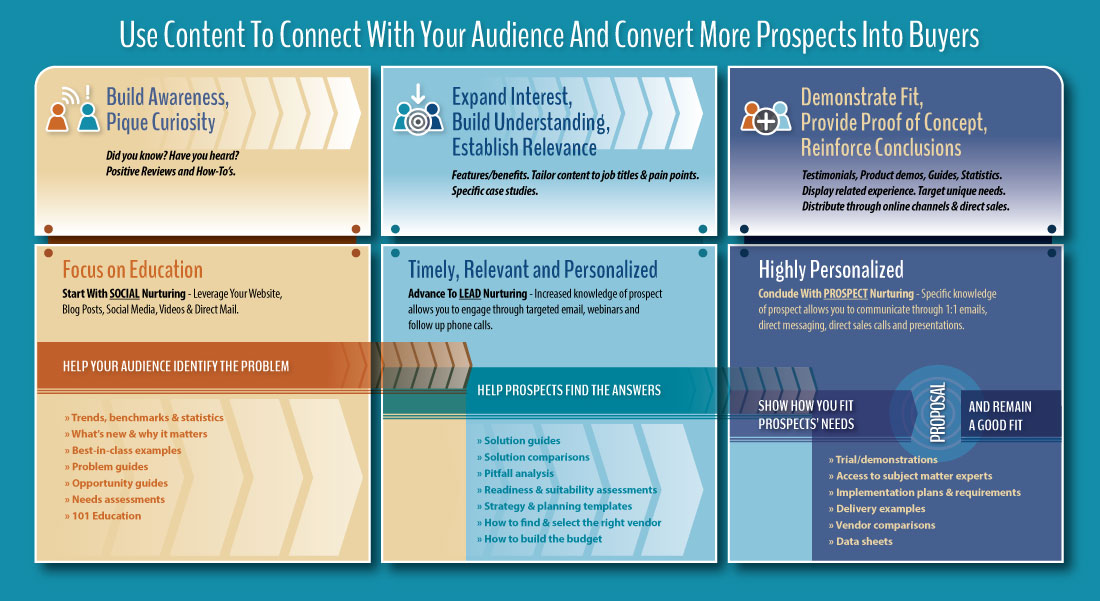 Have you ever written a blog post, webpages or other online content? If it's not your full time job, the task probably takes way too much time. And because it's not a favorite exercise, writing may conveniently drop to the bottom of your to-do list. But when the words flow and the topic connects, writing turns into a rewarding proposition instead of the chore you dread. How do you create more of those moments?
Have you ever written a blog post, webpages or other online content? If it's not your full time job, the task probably takes way too much time. And because it's not a favorite exercise, writing may conveniently drop to the bottom of your to-do list. But when the words flow and the topic connects, writing turns into a rewarding proposition instead of the chore you dread. How do you create more of those moments?
Follow 8 Steps To Develop Better Content
You create more of those moments by following a process. A defined process that you can use consistently to create information your audience values. Because content is essential to buyers formulating purchasing decisions. Creating more frequent, better content will help you attract your ideal customer and convert more prospects into buyers.
The road to consistent, quality content.
1 Start With Research
You know your business. But, research builds on that knowledge, identifying trends, issues and customer needs you aren't thinking about today. It fosters content topic ideas.
Start your research by figuring out people to follow. Websites, authors, blogs, and industry experts provide insights that can translate into a meaningful theme for you. Collect posts, when they are published, using an RSS feed. Readers like Feedly or Digg allow you to aggregate and review articles quickly and save the best options for future use.
Next, build a reading list. Books not only inspire ideas, they help you improve your writing. Best sellers, business topics and popular series all apply. Learn from successful authors and apply those skills to your content.
2 Write It Down - Make A List - Keep A List
How many times do you wake up in the morning with a solution to a problem? Sometimes a random event triggers a brilliant idea. Tap into your subconscious mind! Our past experience and learning spots connections and possibilities. Often, these associations emerge to provide the conscious mind with a clue or hunch that inspires new creativity.
Don't let that inspiration go to waste. With Evernote on your smart phone, a notebook or a scrap piece of paper you can record your hunch and explore that possibility.
Even if developing content is just one of your responsibilities, awareness is a full time job. Stay mindful of the ideas a random event may spark. It will translate into more, better content.
3 Refine Your Topic Ideas
Writing content is far easier when you have numerous topics to choose from. But not all brainstorms translate into great topics. So refine your list and select the best opportunities.
Consider your audience needs. What are common challenges they face? What did your personas uncover? Which topics connect best to those needs? How can you educate and help prospects understand the problems your capabilities solve and the pain points they eliminate?
Ask yourself what type of content best fits the topic? Regular blog posts, downloadable content and web pages can be very helpful for various reasons. Your audience values new, fresh content and so do search engines.
A blog is a great way to create content that's new and fresh.
White papers, solution guides, benchmarks, needs assessments and more educate your audience so when it comes time for that next step, your company is in contention.
A web page can help you clarify the value of your capabilities.
Use these questions to determine which topics to use and the format that best fits each one.
4 Build An Outline
With defined topic ideas in hand, think through the information required to effectively tell your story. For example, here's the outline I developed for this post:
- Intro
- How To Develop Better Content
- Follow A Process
- Research
- Industry Experts
- Authors
- Companies
- Record Your Ideas
- Use An App or Notebook
- Stay Aware
- Refine Your Topics
- How Do They Apply To Your Audience
- Do They Meet Their Goals And Your Goals
- What Type Of Output
- Build An Outline
- Example
- Use An Editorial Calendar
- After The Outline
- Reserve Time Just For Writing
- Uninterrupted
- Comfortable
- Consistent
- Revisit Your Writing
- Reflect And Revise
- You Improve Through Practice
- Get Started
As you think through each step, your outline will evolve. Perhaps you have included a topic that is too basic or should add points that better convey the message.
So, build an outline, let it rest and then go back to review. Does it includes the information you need to tell your story? You'll often identify key points that improve the end product. And when it comes time to write, a thorough outline makes the process simpler.
5 Use An Editorial Calendar
An editorial calendar keeps you on track to create better content. It defines the topic, the publication date, the distribution channels, approvals and other essential details. An editorial calendar holds you and others accountable. It guides your content to-do list.
It's important to utilize an editorial calendar after you develop topic outlines. Thinking through the topic, the key points, the best distribution alternatives and how it fits your audience are important first steps. These insights improve your writing efficiency and produce content that better connects to customer needs.
6 Block Time To Write
Unless you are a naturally gifted writer, it's tough to crank out 300 - 2,000 words in a few minutes. With any job function, productivity improves when you dedicate uninterrupted time to that task. But, this is especially true when creativity is required. The only way to generate better content, consistently is to block out quality time, consistently.
Get everything you need within arms reach. Turn off the phone. Close out email. Put up the crime scene tape to prevent associates from entering your office and disrupting the flow. Or step away from the office into an environment that's conducive to creative thought. I'm at Starbucks. My coffee is on the table next to me. There's a healthy buzz - I guess that's what caffeine does - which helps inspire.
Then write, unencumbered. Ignore misspellings or grammar mistakes. Don't judge. Just let the thoughts flow.
7 Revisit And Revise
Your unencumbered musings require revisions. Spelling, grammar and messaging will all need attention. But so do other things. Can you create a more powerful opening? Do you have passive sentences you can convert into active sentences? Check the vocabulary. Are there better options?
Giving yourself a few days in-between a draft and the final copy provides an important gap. The down time allows you to come back to your content, identify necessary changes and then implement improvements much more effectively.
8 Practice Makes Perfect
How did Michael Jordan become arguably the best basketball player ever? He practiced. His natural talents were propelled into greatness through practice.
You may not be a future Pulitzer Prize winner but regular writing will make you a better writer. You'll produce better content, faster and more effectively.
Get Started
You've developed content before. But using this process will create more enjoyable writing moments and fewer reasons to move content creation to the bottom of your to-do list. And most importantly, it allows you to produce more quality content, connect with prospects, generating more leads and customers!



 Insight Delivered Directly to You Interesting topics, great offers and free marketing tools.
Insight Delivered Directly to You Interesting topics, great offers and free marketing tools.

